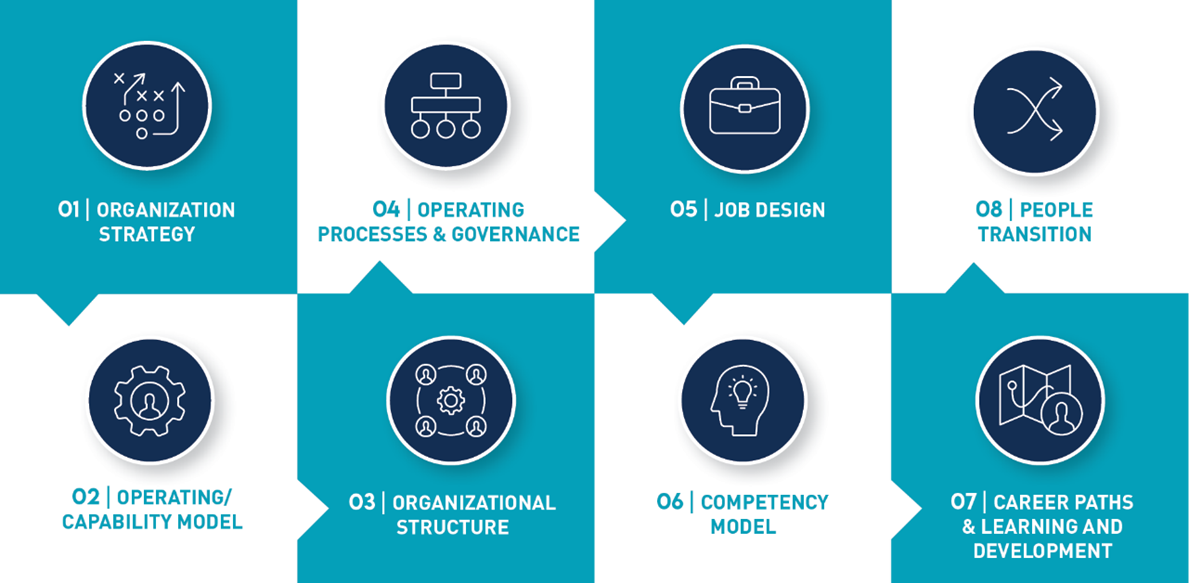In brief:
- Competency models are commonly perceived as outdated documentation of skillsets, but they can and should be more than that.
- When designed effectively, competency models are a powerful tool for the modern organization.
- By connecting individual skills to your overarching business strategy, competencies can become the catalyst for organizational growth, transformation, and competitive advantage, impacting nearly the entire suite of HR functions.
Some human capital professionals will raise their eyebrows when they hear about competency modeling, thinking to themselves, “do organizations still build those?” That’s because competency models are often perceived to be static documentations of skillsets, disconnected from organizational strategy. Worse yet, they can indicate misalignment between HR and the business. Executed incorrectly, a competency model can be an archaic albatross of an HR project, providing isolated organizational value.
We believe there is a better way. We see competency models as a fundamental part of organization design. Few businesses can be run without a clear idea of the core skills its people need, nor a clear picture of the competencies that are relevant to different roles. Executed properly, with dedicated business alignment between change management and HR, a competency model can be a roadmap for employee growth and organizational transformation. Even better, competency models can be a source of competitive advantage.

A competency model still holds incredible value for the modern organization. Our framework for organization design considers how organizational strategies are distilled into operating model development, organizational structure creation, governance and process definition, and day-to-day employee responsibilities implementing a strategy. We translate organizational purpose, visions, and goals from corporate strategy to departmental, team, and individual contribution. As such, competencies are a key tool in defining the required knowledge, skills, or abilities (KSAs) to deliver upon a strategy.
Whether implementing industry-recognized competency models, such as the information technology-centric Skills Framework for the Information Age (“SFIA”), or building new models from the ground up, the most effective competency models provide employee clarity and capture performance outcomes. Consider how your competency models can bridge organizational design and core human capital functions.
A competency model adds value for:
- Recruiting: Providing competencies to inform job descriptions, interview questionnaires, and help hire the right talent.
- Onboarding & Talent Management: Informing the skillset to transition and level up new and existing employees and leaders.
- Performance Management: Clarifying the expectations for employee performance.
- Career Pathing & Succession Planning: Informing employee growth and high-potential retention.
Now let’s look at competency models in practice. Picture your organization embarking on a transformation—say you have decided to implement new Agile ways of working to accelerate value delivery and move toward a product mentality. Let’s consider this transformation from three different perspectives: that of an executive leader, a manager, and an employee at your organization. Let’s explore how competency models for each of these individuals could support the implementation of Agile.
The Executive Leader: At the C-suite level, competency models can be used to define the core, soft, or role-based skills, knowledge, and behaviors that leaders need to bring business strategy to life. These are skills that enable leaders and employees to generate revenue for the business, deliver value to customers, and build the skillset to make change a reality. In some industries—such as energy and utilities or the public sector—certification in specific competencies can mean the difference between contract eligibility or funding access. When embarking on an Agile transformation, leaders may need to acquire new skill sets and behaviors that are not a part of existing learning and development programs; for example, developing product mindsets, implementing design thinking, or utilizing tech-based tools such as Jira.
The Manager: At the Manager level, competency models can help provide clarity around expectations and performance standards for employees. In an Agile transformation scenario, your organization may be restructured into Agile teams. In this case, employees may have new roles, new ceremonies, and new definitions of success. Competency models would need to be adapted to reflect those changes to ensure managers can effectively assess their direct reports’ performance against new ways of working. The revised competency models must have clearly defined standards and narratives for behavior, level, and success (e.g., 1 – 5 ranking and accompanying definition) in alignment with the new Agile ways of working.
The Employee: As soon as words of transition leave leaders’ lips, employees ask, “What does this mean for me? Is my job safe?” Clear competency-driven plans can help leaders quell the concerns of employees who will be impacted by change. If the transition to Agile ways of working leaves an organization wondering what to do with a specific role, defining competencies can help provide the answer. These models should define clear reskilling pathways for employees to transition to a new role. For instance, competency models can identify the skills needed for a Project Manager to move into a Scrum Master role. With clear role-based competency expectations, the career pathing to a new role is simple and clear.
As you consider the current and future state of your organization or industry, ask yourself:
- What strategic changes will require your employees to expand or change their skillset?
- What market or industry changes will affect how your employees work?
- How are you preparing and equipping employees to meet these challenges?
- What roles may increase or diminish in relevance?
- How are you anticipating the needs of the organization to respond to the opportunities ahead?
Consider how a competency model can help you create a clearer path to change. As a senior leader, a manager, or an employee, effectively leveraging a competency model can be the bridge to ensure you, your direct reports or your people can proceed with clarity. And for your organization, it can drive numerous areas of downstream human capital excellence. Competency models don’t have to be stale, tired, or disconnected from the business. Instead, they can be an adaptive tool that drives your transformation forward.
